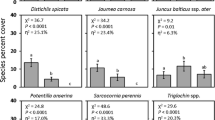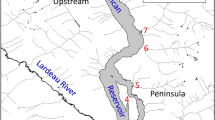ABSTRACT
Although tidal wetland vegetation patterns are typically related to elevation, we hypothesized that the vertical range of a species may shift where the topography is more heterogeneous. We examined plant species occurrences in relation to elevation, proximity to the bay, and proximity to tidal creeks at a near-pristine wetland in San Quintín Bay, Baja California, Mexico. At the whole-wetland scale, most species occurred primarily within a 30-cm elevation band (the marsh plain). However, Spartina foliosa occurred only at the bayward margin, even though “suitable” elevations were present further inland. A similar pattern was found in San Diego Bay. At the microtopographic scale, three species on the marsh plain were strongly influenced by elevation, whereas four species responded to both elevation and proximity to tidal creeks. The latter species tended to “avoid” the lower 10 cm of the marsh plain except near a tidal creek. Species richness was thus greater (by 0.6 species at the lowest 10-cm class) at the tidal creek margin. Better drainage near creeks is the hypothesized cause. Our results help explain why species that are transplanted to constructed wetlands do not always grow at the full range of elevations they occupy in natural wetlands. We recommend that species be introduced to their modal elevation (determined from nearby reference marshes) and that salt-marsh construction designs include topographic heterogeneity (complex tidal creek networks). The analysis of broad-scale and fine-scale patterns of occurrence also suggests new habitat nomenclature. Elevation-based terms (“low,”“middle,” and “high” marsh) should be replaced by a system that considers elevation, landscape position, and conspicuous species. We suggest three habitat designations: (a) the high marsh—a 30- to 70-cm elevation range with Salicornia subterminalis; (b) the marsh plain—a 30-cm elevation range with heterogeneous topography and up to nine common species; and (c) cordgrass habitat—the bayward portion of the marsh plain and lower elevations, all occupied by Spartina foliosa. Although these habitats do not have discrete boundaries, separate terms are needed for wetland restoration plans and these designations will improve recognition that vegetation patterns respond to horizontal, as well as vertical, position.
Similar content being viewed by others
Author information
Authors and Affiliations
Rights and permissions
About this article
Cite this article
Zedler, J., Callaway, J., Desmond, J. et al. Californian Salt-Marsh Vegetation: An Improved Model of Spatial Pattern. Ecosystems 2, 19–35 (1999). https://doi.org/10.1007/s100219900055
Issue Date:
DOI: https://doi.org/10.1007/s100219900055




